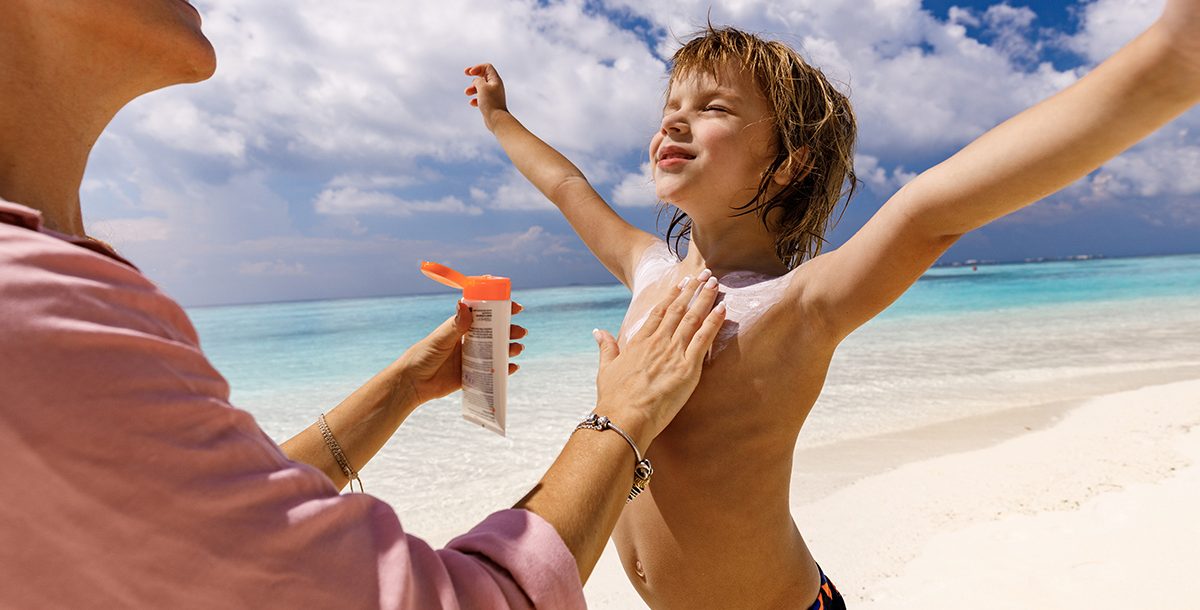There’s no debate – you should wear sunscreen any time you’ll be in the sun, regardless of the weather or the season.
However, not all sunscreens are equal. In terms of ingredients and how they protect your skin from the sun’s ultraviolet, or UV, rays, there are two types of sunscreen:
- Chemical – Chemical sunscreens contain ingredients that are absorbed by your skin and create a chemical reaction when they encounter UV light. That reaction converts UV light into heat, which evaporates from the skin. Most commonly found ingredients are oxybenzone, avobenzone, octisalate, octocrylene, homosalate and octinoxate.
- Mineral – This type of sunscreen sits on top of your skin and physically blocks the sun’s UV rays from entering the skin. Common ingredients used are zinc oxide and titanium dioxide.
Pros and cons of chemical and mineral sunscreen
First off, any sunscreen approved by the Food and Drug Administration (FDA) is considered better than nothing at all. Additionally, the American Academy of Dermatology notes that skin cancer is the most common form of cancer in the United States, and that regular sunscreen use can lead to a reduced risk of melanoma, the most dangerous form of skin cancer.
However, both chemical and mineral sunscreen have their positives and negatives.
Pros of chemical sunscreen are:
- Ease of use, especially on the face, because they should be applied on clean skin before makeup or other lotions
- They are transparent or are absorbed entirely by the skin, meaning no white film
- Better water resistance
Cons of chemical sunscreen include risks for:
- Skin reactions in some people, such as those with sensitive skin, melasma, rosacea and other conditions
- Higher absorption rates of chemicals found in sunscreen
- Damage and bleaching to coral reefs when used in the ocean
Some pros of physical sunscreen include that they:
- Contain the only two ingredients used in sunscreen recognized as safe by the FDA
- Are better for children, people with sensitive skin and those with melasma
- Offer immediate protection from the sun’s UV rays
- Can be applied on top of makeup and other skincare products
Cons of physical sunscreen include:
- Potential for acne breakouts in people who are prone due to its thick consistency and that it sits on top of the skin – some dermatologists recommend a combination of physical and chemical ingredients for people with acne
- They are harder to apply and typically leave a white cast or film on the skin, especially on those with a darker complexion
- They are less water-resistant and require reapplication more often
Alternatives to sunscreen
While sunscreen is generally safe and there are many products on the market today to choose from, some alternatives can be used in combination with sunscreen to increase your protection from the sun.
Avoiding prolonged sun exposure between the hours of 10 a.m. and 2 p.m. can increase your sunscreen’s effectiveness due to the reduced levels of UV rays during the sun’s peak hours. Wearing sun protective clothing and a wide-brimmed hat also provides additional protection.
Regardless of what type of sunscreen you use, as long as it’s a broad-spectrum sunscreen that protects you from both UVA and UVB rays, has an SPF of 30 or higher, is reapplied at least every two hours and doesn’t cause a reaction, your skin will thank you.
Looking for some more summer health tips? Learn about the summer activities that burn the most calories.
Also, learn about all the health care services we offer at Bon Secours.





